ER docs, specialists and their team members shine on TV
Nat Geo WILD's Animal ER in a Houston specialty practice showcases how hard veterinarians and their teams work, how the wonders of modern medicine reach all the way to pets, and where that money from the vet bill goes. (Hint: Better medicine.)
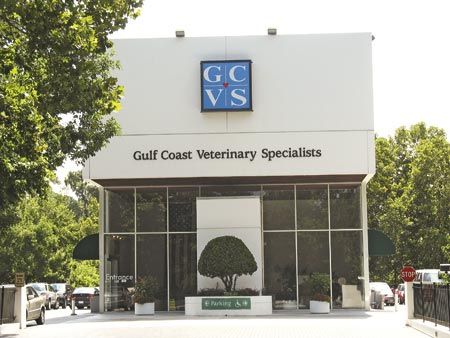
The now TV-famous "white box" of Gulf Coast Veterinary Specialists, opening down to a state-of-the-art animal hospital.
Driving up to Gulf Coast Veterinary Specialists (GCVS) in Houston, Texas, you'd be forgiven for thinking you're in the wrong place. You first see an unassuming brick-and-glass square protruding from a wide swath of parking lot, all surrounded by dense forest. But after entering the "white box," as employees call it, and descending into the hospital proper, you quickly realize that the small building you entered is just the tip of a much larger iceberg and that there's a whole world below the surface.
Originally home to an architecture firm, the building's unique design blends structure with nature. Though near a Houston freeway, the windows of its main floor, set just above ground level, overlook natural forest growth. Inside, busy staff members circulate between oncology, surgery and dental wings, the maze-like halls creating the familiar disorientation of a human hospital.
As with any veterinary practice, most visitors only see the reception area and exam rooms. But the Nat Geo WILD show Animal ER is changing that. Viewers of the show, now in its second season starting Aug. 19, are getting to see below the surface and into the hospital's fascinating maze. More importantly, they're getting to see the veterinary skill and magic that happens in this most unusual place.

Danielle Inman in GCVS' Avian and Exotics department.
Why TV producers love this hospital
When Nat Geo WILD scouted veterinary locations for the show, they settled on GCVS, part of the Compassion-First veterinary hospital network, as a natural fit. The network airs other veterinary shows (including the controversial Incredible Dr. Pol), but this time they wanted a big hospital with cutting-edge medicine and a wide variety of animal clients, from exotics to house pets, that would generate compelling stories.
Surveying the storyboards for the season, Animal ER's executive producer Richard Hall says, “Gulf Coast's clientele is great because Texans own a range of animals, but there are also lots of animal sanctuaries here [in Houston] and private zoos.”
GCVS also occasionally handles animals for the renowned Houston Zoo and features a veterinary team with specialties ranging from orthopedics to neurosurgery, critical care, oncology and nationally recognized dentistry. “It's a great place," Hall says, "because the doctors themselves are just really interesting people. And they do such groundbreaking work.”
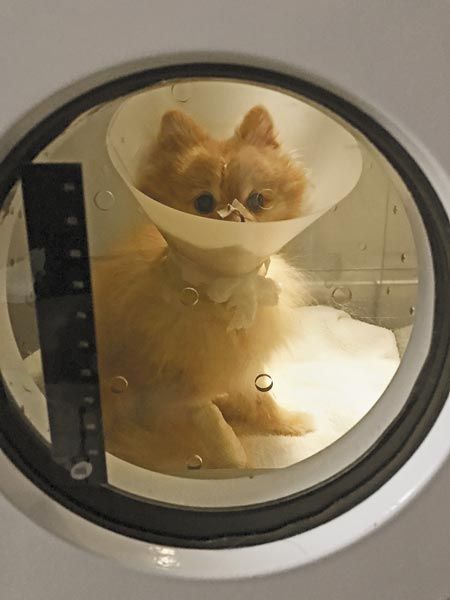
Pomeranian receives treatment for arthritis in a pet-sized hyperbaric chamber at Gulf Coast Veterinary Specialists.
Animal ER features some of the hospital's state-of-the-art equipment and resources in its stories, including the facility's hyperbaric chamber, dialysis machine and cat blood-donor playroom. GCVS also boasts a 24-hour critical care unit in the main building and a secondary location focused on neurology. “People think you're limited in veterinary medicine with what you can do," says Michelle Fabiani, DVM, DACVR, "but every day I talk to people and say, ‘Anything that you've ever done with your doctor, we can do.'"
When your workplace becomes reality TV
In the first season, a dozen team members came in on a Sunday to perform a truly television-worthy hysterectomy on a tiger. Hall describes the event:
“It was a dicey surgery because the infection of the uterus was a lot worse than they thought. And of course with a tiger, you can't keep the anesthesia going for too long and you can't let them wake up too soon. So there was a kind of race against the clock and a very real medical issue. But [the staff] responded really well. It was really one of the most exciting shoots the crew has ever been on. We were all biting our nails. Will the tiger survive? Will they get it out in time? Will it wake up safely from sedation? All of those things happened.”
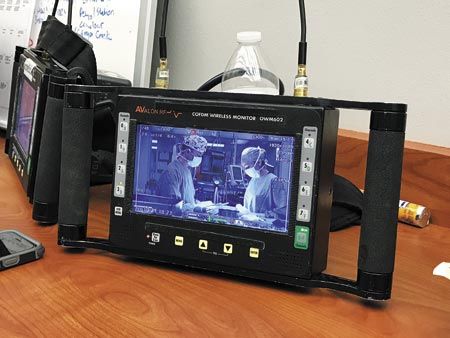
The Animal ER crew relies on remote and wireless devices to stay mobile. This monitor allows the production crew to watch what will become film for the show and report back to the cameraman while he's scrubbed into surgery.
Uncommon surgeries like that create the compelling drama that viewers want from Animal ER. But what's it like for the surgeon performing the surgery to have a cameraman in scrubs hovering nearby? And what's it like to be a part of that camera crew?
For the staff of GCVS, the decision to participate in Animal ER wasn't an easy one. Medical director Heidi Hottinger, DVM, DACVS, explains: “I had incredible trepidation, because I thought this could be really invasive to my clients and staff. I just wasn't sure about how it would take place as well as how it would be portrayed.”
But once the crew arrived, their professionalism put GCVS staffers at ease immediately. “You hardly even notice them,” Dr. Hottinger says. “Our clients have been so accepting, too. The crew prearranges everything, so every client who's involved is fully willing.”
And the crew doesn't just arrange filming for high-stress moments like the tiger's surgery. They see stories through as much as possible, from the exam room to counseling and follow-up appointments.
“They get a complete story from the moment the owner walks into the hospital,” says Brittany Neal, DVM, DACVS.
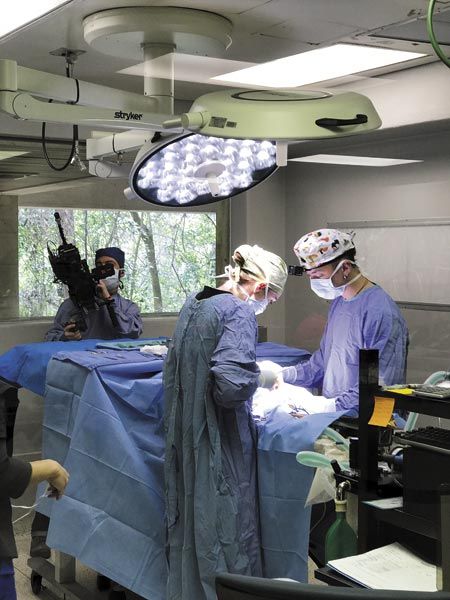
Dr. Brittany Neal, working to remove a tumor from a cat's ear while a cameraman is scrubbed in to catch all the action.
Dr. Neal was on camera the day dvm360 visited GCVS, performing surgery on a cat that had a mass in its right ear canal and an infection causing meningitis. She performed surgery with the film crew looking on.
“[During] the first season, I'd try to narrate while I was doing the surgery so my sentences would come out very spaced out, and I noticed the editors would splice it all together,” Dr. Neal says. “This year, I've learned to focus on the surgery when I need to and then narrate.”
A trickier aspect to film is the comprehensive imaging that GCVS offers. Dr. Fabiani reads images in the dark, but that doesn't exactly translate on TV, so the film crew has taught the doctors how to present their work to make the best impact on viewers. Season two will incorporate imaging that highlights complicated processes, such as performing an ultrasound on a penguin with thick skin and ice requirements that make a routine task complicated.
The crew also tweaked its approach from season to season, pivoting from a focus on the gorier and more extreme aspects of surgery to a focus on the veterinary surgeons and doctors as people and on what it can take for them to handle individual cases.
Showing why we do what we do
Everyone involved in Animal ER, from veterinarians to team members to film crew, work to showcase the true nature of animal hospitals and how the dedicated staff works every day to extend animals' lives.
Dr. Hottinger explains that the show has brought a truly unexpected element to the fore: “You don't always see the impact that you have on families, the good that you're doing and the result of all the long hours that you work. So many staff members, such as kennel technicians and surgery techs, only interact with patients. They never see the pet owners. I saw the team members show a renewed enthusiasm for their jobs because they watched the program.”
The show also provides a unique platform to educate would-be pet owners, especially about certain breeds that have specific health and care needs, such as brachycephalics. In the upcoming season, doctors will tackle prophylactic gastropexy and concerns surrounding gastric dilatation and volvulus. They'll also highlight dermatology, oncology and dentistry. As Dr. Hottinger says, “Pet owners think the treatment is worse than the disease, so it's nice to educate people on what's available and why they don't just have to give up.”
What sets Animal ER apart is the entire veterinary team's commitment to explaining the medicine. Grayson Cole, DVM, DACVS, says, “Hopefully it comes across how dedicated and patient-focused we try to be, but also how much coordination, technology and equipment is required to do these procedures. There are obviously high costs associated with them, and I think once you see how much equipment and personnel time is involved, [your veterinary bill] starts to make more sense.”

The crew of Nat Geo's Animal ER films Dr. Chanda Miles as she investigates a growth in a dog's jaw.
Chanda Miles, DVM, DAVDC, also notes that it's hard for pet owners to know what goes on behind the scenes, because “[they] just see how their pet acts when they get home. Your animal gets a team of people, an ICU staff person, general staff, and round-the-clock monitoring. The show displays all of that.”
From the crew's perspective
Perhaps the significance of Animal ER is best illustrated by the effect it's had on the film crew, some of whom are from Los Angeles. As executive producer Hall explains, “We come here [to Houston] and live for eight weeks, and each year at least one of our members has brought their dog with them. And each year they bring their dog in for a checkup to take advantage of what's going on here.”
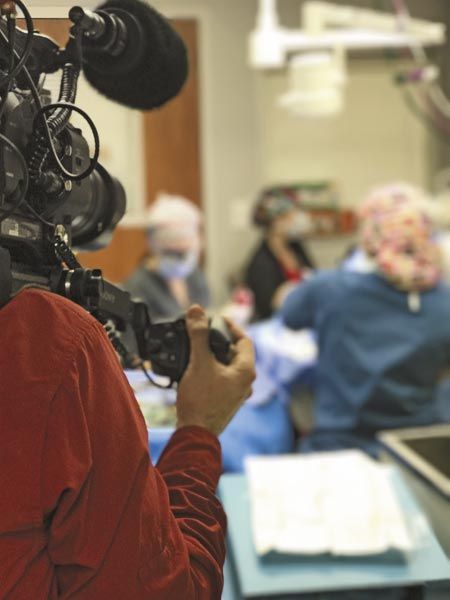
The show excels at showing the bond between humans and animals and then taking it a step further to show the dedication of veterinarians. “They really wanted to portray the vet profession as where we are, where we have come,” says Dr. Hottinger.
The film crew's admiration for the staff of the hospital shines throughout the show. As Hall puts it, “They're proud of what they're doing, and they do it really well. So we're celebrating their work.”
Christine Cox and Dacia Clay are freelance writers in the Houston area.
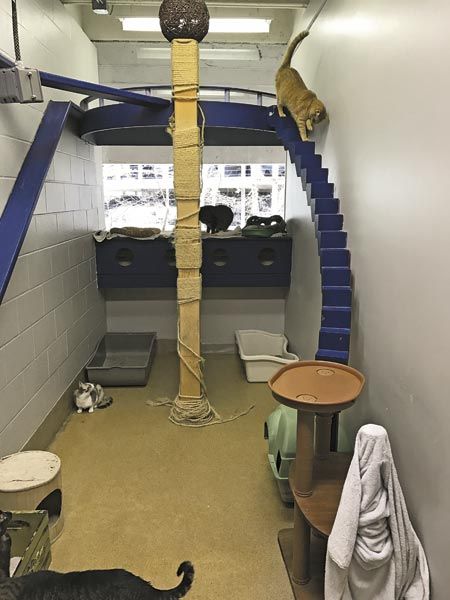
The cat blood donor room at Gulf Coast Veterinary Specialists, equipped with a private window and constant staff attention.
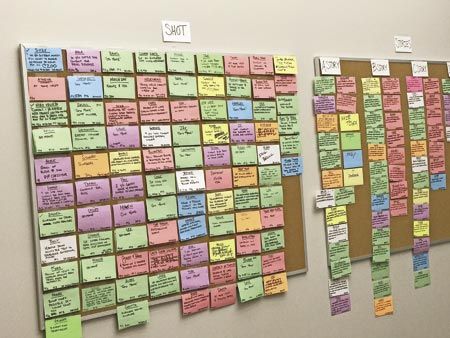
The Animal ER storyboard for season two, color coded by medical department.
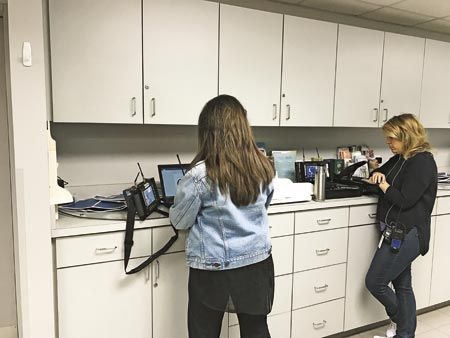
The production crew watches camera shots and reports back on angles and sound, taking notes for future editing.
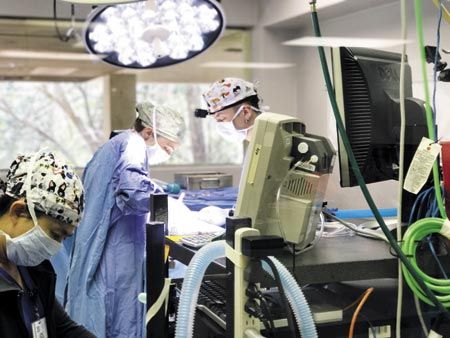
Dr. Brittany Neal and her team performing surgery to remove a tumor from a cat's ear that led to a meningococcal infection. She narrates the surgery while a cameraman captures the details on film.
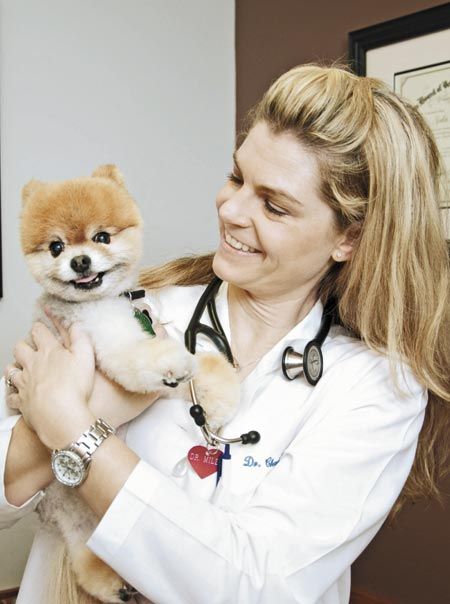
Dr. Chanda Miles and her expansive dentistry knowledge get more coverage in season two, highlighting the necessity of good pet dental health.